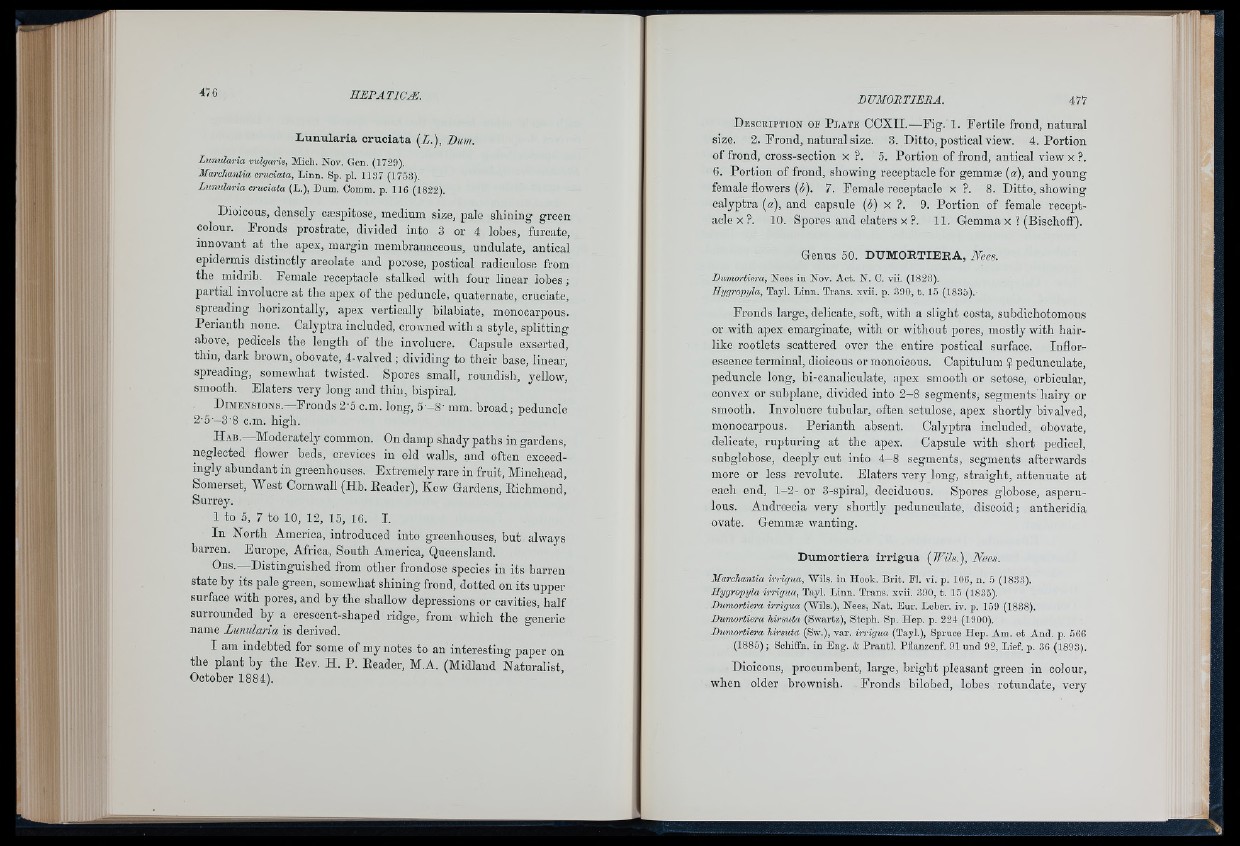
Ml I
i'U
Lunularia cruoiata (Z.), Bum.
Lumdaria vidgams, Mich. Nov. Gen. (1729).
Marchantia cruciata, Linn. Sp. pi. 1187 (1753).
lum d a r ia cruciata (L.), Dum. Comm. p. 116 (1822).
Dioicous, densely cæspitose, medium size, pale shining green
colour. Fronds prostrate, divided into 3 or 4 lobes, furcate,
innovant at the apex, margin membranaceous, undulate, antioal
epidermis distinctly areolate and porose, postieal radiculose from
the midrib. Female receptacle stalked with four linear lobes ;
partial involucre at the apex of the peduncle, quaternate, cruciate,
spreading horizontally, apex vertically bilabiate, monooarpous.
Perianth none. Calyptra included, crowned with a style, splitting
above, pedicels the length of the involucre. Capsule exserted,
thin, dark brown, obovate, 4-valved ; dividing to their base, linear,
spreading, somewhat twisted. Spores small, roundish, yellow,
smooth. Elaters very long and thin, hispiral.
D im e n s io n s .— Pronds 2-0 c.m. long. S'-S' mm. broad; peduncle
2-5'-3-8 c.m. high.
H a b .— Moderately common. On damp .shady paths in gardens,
neglected flower beds, crevices in old walls, and often exceedingly
abundant in greenhouses. Extremely rare in fruit, Minehead,
Somerset, West Cornwall (Hb. Eeader), Kew Gardens, Eichmond,
Surrey.
1 to 5, 7 to 10, 12, 15, 16. I.
In .North America, introduced into greenhouses, hut always
barren. Europe, Africa, Soutli America, Queensland.
O b s .—Distinguished from other frondose species in its barren
state by its pale green, somewhat shining frond, dotted on its upper
surface with pores, and by the shallow depressions or cavities, half
surrounded by a crescent-shaped ridge, from which the generic
name Lunularia is derived.
I am indebted for some of my notes to an interesting paper on
the plant hy the Eev. H. P. Eeader, M.A. (Midland Naturalist,
October 1884).
D e sc r ip t io n of P l a t e CCXII.—Pig. 1. Fertile frond, natural
size. 2. Frond, natural size. 3. Ditto, postical view. 4. Portion
of frond, oross-section x ?. 5. Portion of frond, antioal view x ?.
6. Portion of frond, showing receptacle for gemmæ {a), and young
female flowers (¿). 7. Female receptacle x ?. 8. Ditto, showing
calyptra [a), and capsule (¿) x ?. 9. Portion of female receptacle
x ?. 10. Spores and elaters X ?. 11. Gemma x ? (Bischoff).
Genus 50. DUMORTIERA, Nees.
Bimim-tiera, Nees in Nov. Act. N. 0 . vii. (1823).
JJygropyla, Tayl. Linn. Trans, xvii. p. 390, 1 .15 (18.35).
Fronds large, delicate, soft, with a slight costa, subdichotomous
or with apex emarginate, with or without pores, mostly with hairlike
rootlets scattered over the entire postieal surface. Inflorescence
terminal, dioicous or monoicous. Capitulum Ç pedunculate,
peduncle long, bi-canalieulate, apex smooth or setose, orbicular,
convex or subplane, divided into 2-8 segments, segments hairj' or
smooth. Involucre tubular, often setulose, apex shortly bivalved,
monooarpous. Perianth absent. Calyptra included, obovate,
delicate, rupturing at the apex. Capsule with short pedicel,
subglobose, deeply cut into 4-8 segments, segments afterwards
more or less revolute. Elaters very long, straight, attenuate at
each end, 1-2- or 3-spiral, deciduous. Spores globose, asperulous.
Androecia very shortly pedunculate, discoid; antheridia
ovate. Gemmæ wanting.
Dumortiera irrigua (JFils.), Nees.
Marchantía irrigua, Wils. in Hook. B rit. El. vi. p. lOG, n. 5 (1833).
Hygropyla iìTÌgua, Tayl. Linn. Trans, xvii. 390, t. 15 (1835).
Dumortiera irrigua (Wils.), Nees, Nat. Eur. Leber, iv. p. 159 (1838).
Dumortiera hirsuta (Swartz), Steph. Sp. Hep. p. 224 (1900).
Dumortiera hirsuta (Sw.), var. irrigua (Tayl.), Spruce Hep. Am. e t And. p. 50G
(1885) ; Schiffn. in Eng. & P ran tl. Pflanzenf. 91 und 92, Lief. p. 3G (1893).
Dioicous, procumbent, large, bright pleasant green in colour,
when older brownish. Fronds bilobed, lobes rotundate, very